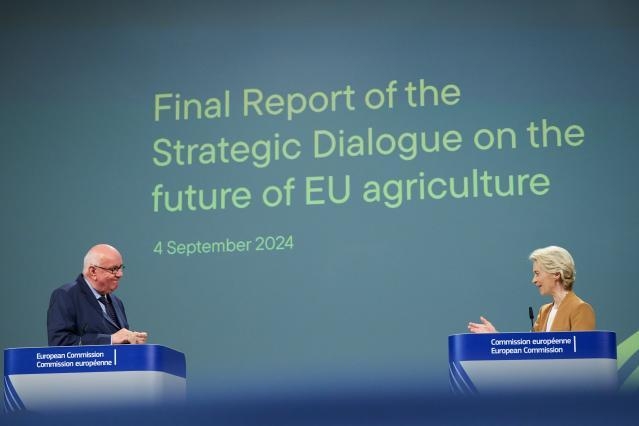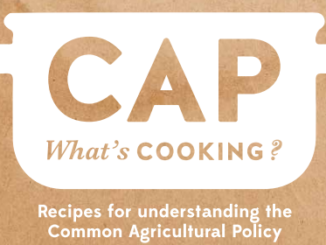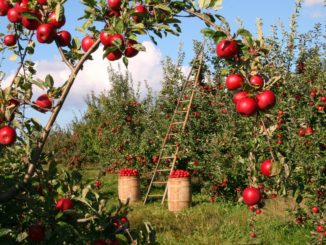
The EU strategic dialogue on agriculture has finally spoken – and plenty has emerged. After 7 months of talks, this group of agrifood stakeholders presented a hefty 100+ page document including recommendations for the future shape of the agrifood sector to Commission President Ursula von der Leyen, on Wednesday (4 September). The group hopes to steer her upcoming Vision for Agriculture and Food, and policies over the course of the next 5-year political cycle more widely. So what are the key takeaways? And what’s next? ARC’s Natasha Foote highlights the key headlines and ideas.
Strategic Dialogue Proposals at a Glance – top ten takeaways
- Move CAP towards viability and income and away from area-based payments
- Create an Agricultural Just Transition Fund
- Create Nature Restoration Fund
- Create a European Observatory of Agricultural Land (and no net land take by 2050)
- Create a harmonised benchmarking system for sustainability
- Take a more territorial focus for policy formation
- Incentivise sustainable and healthy diets, including plant-based proteins
- Revise public procurement away for cheapest towards best value options
- Establish a “European Rural Contact” and “rural test” for big budget changes such as the MFF
- Promote locally adapted and peasant farms including via strengthened and new short supply chains
Bonus takeaway –
Keep the show on the road! Turn this dialogue into a European Board of Agri-Food (EBAF) (aka a permanent dialogue).
Quick background – what is this dialogue group?
The strategic dialogue group, made up of 29 agrifood stakeholders from all sides of the agrifood food chain including farmers’ groups, civil society and industry, was put together by President von der Leyen back at the beginning of the year in efforts to bridge the polarisation in the sector on the back of a series of farmers’ protests across the EU.
Entitled ‘A shared prospect for farming and food in Europe’, the report – which has won the blessing of all 29 members and was drafted by the group’s independent chair, Professor Peter Strohschneider – presents an assessment of challenges and opportunities, followed by a set of recommendations.
Read/Download the strategic-dialogue-report-2024 in full (en)
Read/download the Executive Summary if the Strategic dialogue report 2024 (en)
These suggestions will then feed into the European Commission’s ‘Vision for Agriculture and Food’, promised within the first 100 days of President von der Leyen’s second mandate.
How many of these recommendations will make it into her next set of agrifood policies remains to be seen. But von der Leyen did offer her assurances during a press conference that she will, together with her team, “study carefully” the report’s recommendations and use these as a basis for her upcoming roadmap.
And, at least for this first round of outcomes, everyone involved seems quite happy with both the process and the result – so happy, in fact, that the group has suggested formalising into a, new, permanent structure: the self-titled ‘European Board of Agri-Food (EBAF)’. This new governance model is designed to foster a “new culture of cooperation, trust and multi-stakeholder participation”.
So what are the headline takeaways?
On the farm side …
First things first and, arguably, most revolutionary, are the suggestions to overhaul the EU’s farming subsidy programme to link subsidies to income in efforts to start (albeit gently) moving away from hectare-based payments.
“The future [Common Agricultural Policy] should focus on these central objectives: (1) providing socio-economic support targeted to the farmers who need it most; (2) promoting positive environmental, social, and animal welfare outcomes for society; and (3) invigorating enabling conditions for rural areas,” the report sets out.
To better target support, subsidies should be linked to farmers’ economic viability, meaning the CAP should “deliver income support for certain active farmers in a much more targeted way” to support those most in need, in particular small and mixed farms, young farmers, new entrants and in areas with natural constraints.
Not only is this needed to ensure that funding goes to those who need it most, but the idea is also to futureproof the policy for the EU’s enlargement process, notably the addition of agricultural powerhouse Ukraine.
As with many of the ideas in the report, it’s not fully fleshed out. Instead, the suggestions are supposed to give indications for the direction of travel, leaving it up to policymakers and experts to sort out the details (and all the devils in these).
There’s also plenty of focus on strengthening farmers’ position in the food chain, although this mostly focuses on ways to improve farming efficiencies and maximise farmers’ market opportunities rather than offering any price setting power.
Another notable suggestion is the creation of two new funds: the first, an ‘Agriculture Just Transition Fund’, modelled on the EU’s Just Transition Fund and which focuses specifically on the sustainable transition – e.g. helping to fund solutions in areas with a high concentration of livestock – and a second, the Nature Restoration Fund.
While there are no details on how this would be funded, the group is very clear on one thing – that this money must come from outside the CAP. For instance, some have suggested this funding could be pulled from Cohesion and Regional funding pots.
There’s also an idea for a new ‘benchmarking’ system to help harmonise methodologies of on-farm sustainability assessments based on “common objectives, principles, and criteria, and include monitoring and verification tools with common metrics and indicators” to help direct comparisons across diverse sustainability objectives and ambitions. The group also recommends adopting a territorial approach to policy-making, including territorial action plans to tailor the best sustainability approach for that specific region.
Other notable recommendations include the creation of an European Observatory for Agricultural Land, coupled with a legally binding objective of ‘no net land taken by 2050’. Dialogue members also urged President von der Leyen to table an animal welfare legislation overhaul, which was an original ambition of her (more-or-less forgotten) Farm to Fork strategy.
Generational renewal also earns a central focus, including facilitating land mobility, adequate financial support, and better education are crucial to attract young farmers to the sector. There’s also a healthy dose of the usual knowledge sharing, with a strong emphasis on innovation and new technology (read: NGTs, digitalisation, etc.)
Lastly, the group calls for a greater coherence between its trade and sustainability policies, and a renewed approach to considering the agrifood sector in trade negotiations.
… And on the ‘fork’ side
As a first reaction, there certainly seems to be more on the two ends of the agrifood chain, aka more focus on farmers and consumers than the retailers in the middle. (For instance, the word ‘farm’ is mentioned a whopping 389 times in the report, while ‘market’ earns 90 mentions and ‘retail’ is mentioned a mere 12 times – just to give a flavour).
However, there is the promised overhaul of the EU’s Unfair Trading Practices (UTP) Directive, in which the group calls for an “effective, balanced and proportionate framework” which includes the effective enforcement of UTP legislation, mediation between commercial partners as a way to solve disputes; and national enforcement authorities with the teeth to do something about it.
There are also suggestions to promote cooperation initiatives between farmers and other supply chain actors in ways which support and reward farmers for their sustainability efforts.
On the consumer side of things, it gets a bit meatier – or, should I say, less meaty and more plant based protein-y, as one of the key recommendations is to support a rebalancing towards plant-based options and helping consumers to “embrace the transition”.
To help nudge the “increasingly interested” consumers along, a number of fiscal policies are suggested, such as tax reductions on sustainable food products (although this would be member states’ prerogative as they have the power when it comes to tax) to “foster coherent price signals” and safeguard food affordability for lower income consumers.
There are also suggestions on pushing on the power of public procurement – another hangover from the Farm to Fork which never saw the light of day. To this end, the group calls on the Commission to propose a revision of the public procurement framework to remove the possibility for member states to use the lowest price criterion alone as the determining criterion for the award of tenders in essential services and labour-intensive industries, including contract catering. The revised EU Public Procurement should instead enshrine a “best value approach” instead, which rewards quality, including the sustainability of the food to be provided as part of the service.
There are also some new proposals on labelling, with dialogue participants calling for a “full review of EU food labelling legislation”, as well as a report evaluating the current measures relating to the marketing to children. There is also a call for a new animal welfare labelling scheme.
And not forgetting rural in all this!
The report also calls for the vitality and attractiveness of rural areas to be “significantly raised” by implementing the long-term vision for rural areas and establishing a European rural contract.
This contract would be developed alongside a so-called ‘rural test’ ahead of decisions on the EU’s budget, the Multiannual Financial Framework. This test is explained as a coherent set of policy measures to assess the likely impact of major EU legislative initiatives on rural areas and populations in their diversity and to avoid territorial desertification.
The report also offers recommendations on the promotion of locally adapted and peasant farms, of similar structures for sustainable forms of agricultural production as a way to contribute to the “dense rural fabric” by, for example, establishing new and strengthening short supply chains.
So what next?
At the end of the day, these are all just suggestions, and the Commission is not obliged to act on them. But President von der Leyen convened this dialogue group to feed into her ideas on how to move forward, so the chances are high that at least a strategic number of these will be acted upon. But we won’t know to what extent these will be taken into consideration until the publication of her Vision for Agriculture and Food, due to come within the first 100 days of her next round at the top Commission job.
While we wait, ARC2020 will dig deeper into these ideas over the coming days and weeks, so watch this space for more analyses to come. Below see who the participants in the Strategic Dialogue are.
More
News Roundup: Brussels plays musical chairs, responsibility reshuffle, and a big week ahead






